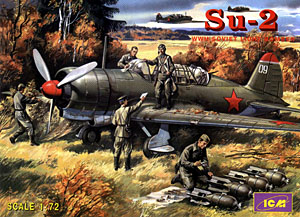History Development of the Su-2 began as far back as the 'Ivanov' specification of 1936; basically, a directive by Stalin for modern attack and reconnaissance machines. The prototypes were developed under the stewardship of the Tupolev Bureau by Pavel Sukhoi's Brigade and was designated ANT-51. The three prototypes--commonly known as SZ-1, -2, and -3-- featured all-metal construction. The wing was a twin-spar unit of three sections, the center being made integral with the fuselage, and was dural skinned. The fuselage was a monocoque structure with very thick (9mm) wood-laminate surfaces, and the metal framed control surfaces were fabric covered. Handling in the ANT-51 was quite good, and during the SZ-3's State Acceptance Trials in 1940 the NII VVS institute pilots commented favorably on the aircraft. Aileron response was especially light and effective, with well coordinated controls, while the low-speed handling properties were considered safe even for pilots with minimal training. The SZ-3 was also designed for excellent crew protection, large sheets of 9mm armor plate covering the vital cockpit areas. The aircraft entered production in 1940 as the BB-1 ('blizhniy bombardirovchik'); later in the same year the designation was changed to Su-2 to accomodate the new aircraft naming convention. Powered by the 950 hp M-88 radial, the BB-1 was armed with four ShKAS guns in the wings, a further such weapon being mounted in an MV-5 turret at the aft end of the long canopy. Internal bomb bays accommodated four 100kg bombs, while externally mounted stores ranged from two 250kg weapons to ten RS-82 rockets. In 1941 production was expanded to two further facilities, and the 1000 hp M-88B engine became standard. Performance in these updated version rose to 233 mph at sea level and 291 mph at 20,400 ft. Batches of Su-2s were also completed at Zavod 135 with the 1400 hp M-82 radial, this variant featuring much improved climb and low altitude performance. Success did not attend the Su-2 in combat, however, and only some 877 Su-2s (and -4s) were completed before production was terminated in 1942. 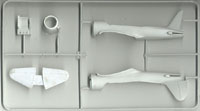 The Kit The Kit
The ICM Su-2 consists of 58 light gray injected molded pieces and 10 injected clear parts. There are decals for two schemes - an Su-2 of the 226 Bomber Regiment, South-Western Front, July 1941, and an Su-2 of the 67th Special Corps Squadron, Brovary, June 1941. ICM provides a couple of options in this kit as well. First is the "turtledeck"; two separate pieces that I have no idea which one to use and why. The second option is for wheels up - the landing gear covers are one piece and you have to cut them apart if you're going to build it gear down. Same with the tail wheel. There are two parts provided - one for gear up, one for gear down. The exterior detail is very well done. The fabric surfaces and rivet details are very petite and too scale. However… Yes, unfortunately there is a "however". There are a lot of "dimples" and "sink marks" in this kit, and removing them will result in the removal of some of the external detail. For example, on the fuselage directly behind the cowl is a "band" that almost entirely consists of dimples. The wing roots at the trailing edge has large dimples. The flaps on the top wing portions have nothing but dimples and the removal of these will eradicate all external detail. There are dimples 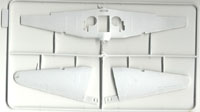 in the horizontal tail roots. There are also dimples in two of the three belly clear pieces! in the horizontal tail roots. There are also dimples in two of the three belly clear pieces! Now, if these problems are indicative of my kit only I don't know. If it is, then ICM has a quality control problem. If not, then there are problems with the molds. Another unfortunate aspect to this kit is how ICM broke up the wings. I personally don't like kits that have their wings split in a control surface hinge area - which the 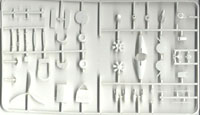 Su-2 is. I prefer the kit to be "split" on the leading and trailing edges. I suspect that if this was the way ICM did the Su-2, the "dimpling" on the flaps and other surfaces wouldn't have been as great. Another unfortunate with the wings is the lack of boxed in wheel wells. It's very easy to see through the entire wing when looking into the wheel well area. Su-2 is. I prefer the kit to be "split" on the leading and trailing edges. I suspect that if this was the way ICM did the Su-2, the "dimpling" on the flaps and other surfaces wouldn't have been as great. Another unfortunate with the wings is the lack of boxed in wheel wells. It's very easy to see through the entire wing when looking into the wheel well area. Even with these problems it's a nice kit. The cockpit detail is "decent" if keeping the clear pieces closed. However, if opening up any of the clear pieces then interior detail 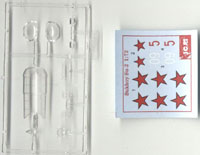 will need to be added. The engine is very well done and looks the part. The landing gear is really nice and looks like Su-2 gear. will need to be added. The engine is very well done and looks the part. The landing gear is really nice and looks like Su-2 gear. Conclusion It's really unfortunate that there are the mentioned problems with this kit. The Su-2 has needed a well done injected molded kit for quite a long time, and I wish ICM had done a better job with this important aircraft. Can it be built? Of course! However, be prepared for a lot of surface work, especially if wanting to restore any of the detail that was removed during part clean up. | 


 



  
|
